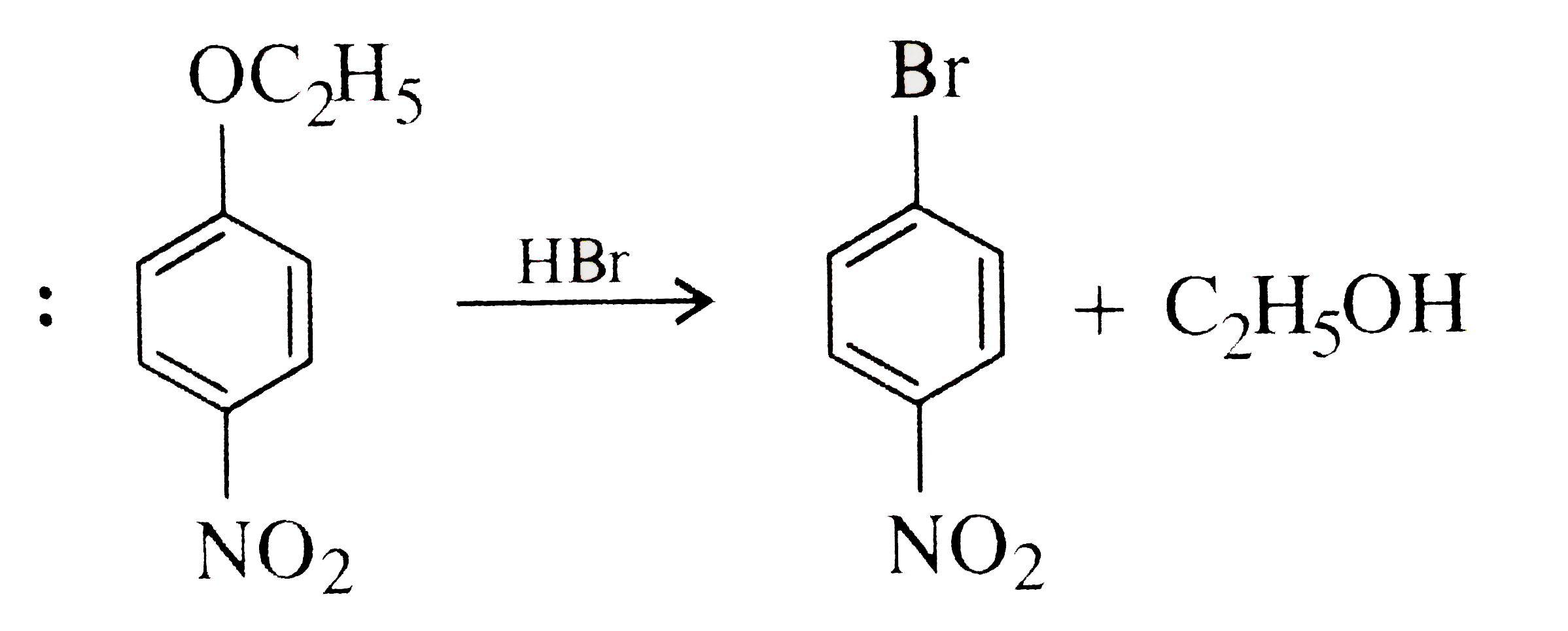Assertion : When Alkyl aryl ethers react with excess of hydrogen halides, phenol and Alkyl halide are produced. Reason: Alkyl aryl ethers are cleaved at the Alkyl-oxygen bond due to more stable Aryl-oxygen bond.
if both assertioon and reason are true and reason is the corrct explanation of assertion.
If both assertion and reason are ture but reason is not the corrcet explanation of assertion.
If assertion is true but reason is false .
if both assertion and reason are false.
The correct Answer is:A
To solve the question, we need to analyze the assertion and reason provided regarding the reaction of alkyl aryl ethers with hydrogen halides.
1. Understanding the Assertion:
The assertion states that when alkyl aryl ethers react with excess hydrogen halides, they produce phenol and an alkyl halide.
- For example, consider the ether anisole (C6H5OCH3) reacting with HBr. The products of this reaction would be phenol (C6H5OH) and bromoethane (CH3Br).
2. Understanding the Reason:
The reason provided states that alkyl aryl ethers are cleaved at the alkyl-oxygen bond due to the more stable aryl-oxygen bond.
- In ethers, the bond between the aryl group (C6H5) and oxygen is stronger and more stable compared to the bond between the alkyl group (CH3) and oxygen. Thus, during the reaction with hydrogen halides, the alkyl-oxygen bond is broken preferentially.
3. Mechanism of Reaction:
- When the ether reacts with hydrogen halide, the oxygen atom in the ether donates its lone pair to the hydrogen ion (H+), resulting in a protonated ether.
- The protonated ether then undergoes nucleophilic attack by the halide ion (Br-), which attacks the less sterically hindered side (the alkyl side), leading to the cleavage of the alkyl-oxygen bond.
- This results in the formation of phenol and the corresponding alkyl halide.
4. Conclusion:
- Both the assertion and the reason are correct. The assertion correctly describes the products formed when alkyl aryl ethers react with hydrogen halides, and the reason correctly explains the mechanism behind the reaction.
Final Answer:
Both the assertion and reason are true, and the reason correctly explains the assertion.
The assertion states that when alkyl aryl ethers react with excess hydrogen halides, they produce phenol and an alkyl halide.
- For example, consider the ether anisole (C6H5OCH3) reacting with HBr. The products of this reaction would be phenol (C6H5OH) and bromoethane (CH3Br).
The reason provided states that alkyl aryl ethers are cleaved at the alkyl-oxygen bond due to the more stable aryl-oxygen bond.
- In ethers, the bond between the aryl group (C6H5) and oxygen is stronger and more stable compared to the bond between the alkyl group (CH3) and oxygen. Thus, during the reaction with hydrogen halides, the alkyl-oxygen bond is broken preferentially.
- When the ether reacts with hydrogen halide, the oxygen atom in the ether donates its lone pair to the hydrogen ion (H+), resulting in a protonated ether.
- The protonated ether then undergoes nucleophilic attack by the halide ion (Br-), which attacks the less sterically hindered side (the alkyl side), leading to the cleavage of the alkyl-oxygen bond.
- This results in the formation of phenol and the corresponding alkyl halide.
- Both the assertion and the reason are correct. The assertion correctly describes the products formed when alkyl aryl ethers react with hydrogen halides, and the reason correctly explains the mechanism behind the reaction.
Both the assertion and reason are true, and the reason correctly explains the assertion.
Topper's Solved these Questions
Similar Questions
Knowledge Check
- Question 1 - Select One
Aniline reacts with excess alkyl halide to give
Aamino compoundBtertiary compoundCazomethaneDquaternary ammonium compound - Question 2 - Select One
Aniline reacts with excess of alkyl halide to give
Aamino compoundBtertiary compoundCazonmethaneDquatermary ammonium compound - Question 3 - Select One
Assertion :

Reason : Alkyl arly ethers on reaction with halogen acids always from aryl halide due to formation of more stable carbocation.AIf both assertion and reason are correct and reason is correct explanation for assertion.BIf both assertion and reason are correct but reason is not correct for assertion.CIf assertion is correct but reason is incorrect.DIf both assertion and reason are incorrect.
Questions based on Alkyl Halides and Aryl Halides
View SolutionAlkyl aryl ethers on treatment with HI gives alkyl iodide not aryl iodide , expalin why ?
View SolutionAssertion (A): Alkyl aryl ethers on reaction with HI give alkyl iodide phenols
Reason (R): Aryl - oxygen bond is weaker than alkyl oxygen bondView SolutionAlkyl halides react with Mg in dry ether to form
View SolutionAryl halides are less reactive than alkyl halides because of
View Solution

